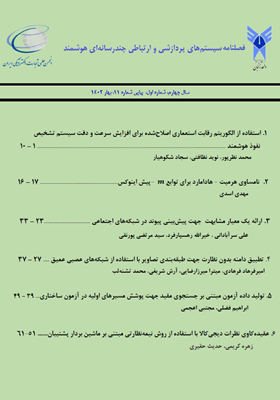تطبیق دامنه بدون نظارت جهت طبقهبندی تصاویر با استفاده از شبکههای عصبی عمیق
محورهای موضوعی : پردازش چند رسانه ای، سیستمهای ارتباطی، سیستمهای هوشمند
امیرفرهاد فرهادی
1
,
میترا میرزارضایی
2
*
![]() ,
آرش شریفی
3
,
محمد تشنه لب
4
,
آرش شریفی
3
,
محمد تشنه لب
4
1 - دانشجوی دکتری، گروه مهندسی کامپیوتر، واحد علوم و تحقیقات، دانشگاه آزاد اسلامی، تهران، ایران
2 - استادیار، گروه مهندسی کامپیوتر، واحد علوم و تحقیقات، دانشگاه آزاد اسلامی، تهران، ایران
3 - استادیار، گروه مهندسی کامپیوتر، واحد علوم و تحقیقات، دانشگاه آزاد اسلامی، تهران، ایران
4 - استاد، گروه مهندسی کنترل، دانشگاه صنعتی خواجه نصیرالدین طوسی، تهران، ایران
کلید واژه: شبکههای تخاصمی مولد, شبکه عصبی پیچشی, خوشهبندی فازی, تطبیق دامنه, WMMD,
چکیده مقاله :
تطبیق دامنه می تواند دانش را از یک مجموعه آموزشی (دامنه منبع) به یک مجموعه آزمایشی (دامنه هدف) انتقال دهد تا بازدهی مدل یادگرفته شده از داده های آموزش، افزایش یابد. در حیطه تطبیق دامنه مسائل به دو بخشِ با نظارت و بدون نظارت تقسیم بندی می شود. در این پژوهش دامنه های بدون نظارت مورد بررسی قرارمیگیرد. یکی از چالشها در تطبیق دامنه که به آن کمتر توجه شده است، عدم توجه به زیرفضا دامنه (فشردگی درون کلاسی) و همچنین تاثیر مخرب دادههای نویزی و خارج از محدوه است، که موجب انتقال منفی و در نهایت موجب کاهش دقت طبقهبندی میشود. در این مقاله با استفاده از شبکه تخاصمی مولد جهت استخراج ویژگیها با درنظرگرفتن فشردگی درون-کلاسی دامنهها بر مبنای تخمین اولیه برچسبها با کمک الگوریتم خوشهبندی فازی c-means در گام اول و در گام دوم با کمک شبکههای عصبی پیچشی و متریک WMMD جهت طبقهبندی تصاویر با خطای کمتر ارائه شده است. ارزیابی و نتایج به دست آمده در 5 مجموعه داده محک استاندارد و مقایسه آن با روشهای پیشین نشان دهنده عملکرد بهتر نسبت به رهیافتهای مشابه میباشد.
Introduction: Domain adaptation has become an important issue today. A high percentage of data processing domain adaptation is done with a significant percentage of studies related to deep learning. Traditional methods often ignore the distance between the intra-class in source domain and target domain. As a result, models can be sensitive to outliers and noisy data, additionally increasing the negative transfer in the model. This method applied GAN to extract appropriate features and then used Fuzzy c-means to cluster train datasets in the target domain. Finally, based on the WMMD metric and CNN, the model estimates the final label data. Five real datasets are selected to generate eight transfer tasks. The results show that the superiority of the proposed model lies in transferring more knowledge from the source domain to the target domain.Method: In this approach, firstly based on GAN extracting features from source domains and the target domain (without labels), then label estimation by Fuzzy c-means clustering, finding the center of Fuzzy c-means on target domain data, new data points with labels in target domain as a new input to feature extraction module and regenerate features by GAN based on new pseudo labels. Afterward, we apply WMMD metrics based on CNN to ultimately assign labels for the target domain. Consequently, classification tasks have been done.Results: Empirical results on various benchmark datasets showcase the exceptional performance of the proposed method compared to state-of-the-art DA approaches, validating the proposed Deep-Learning Unsupervised Domain Adaptation approach efficacy. Overall, the approach shows potential for advancing domain adaptation research by offering an efficient and resilient approach for addressing domain shifts in real-world applications. Experimental results on visual object recognition and a digit dataset reveal that the proposed algorithm is robust, flexible, and significantly superior regarding accuracy compared to the baseline DA approaches. Based on the three and combined digit datasets, 1.7% and 2.4% accuracy improvement are achieved, respectively, compared to the best baseline DA approach results.Discussion: In this research, we addressed the challenging issues of outlier and negative transfer in the context of domain adaptation. Despite significant progress in domain adaptation techniques, outliers and negative transfer instances continue to hinder models' generalization performance across different domains. Based on DNNs and the WMMD metric, our proposed method was designed to mitigate these issues and effectively enhance knowledge transfer between domains.
_||_

